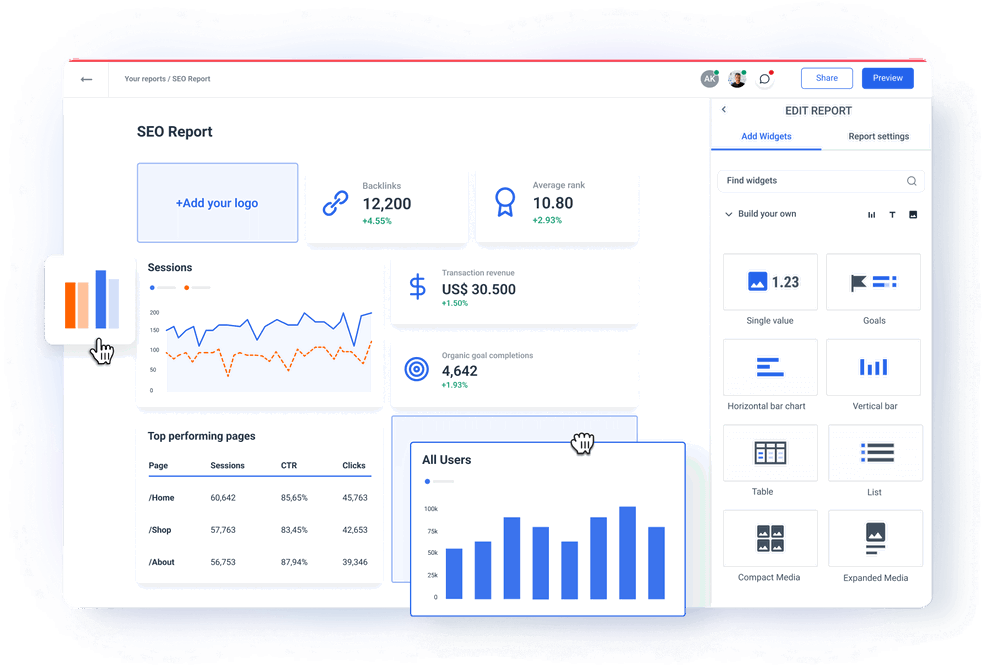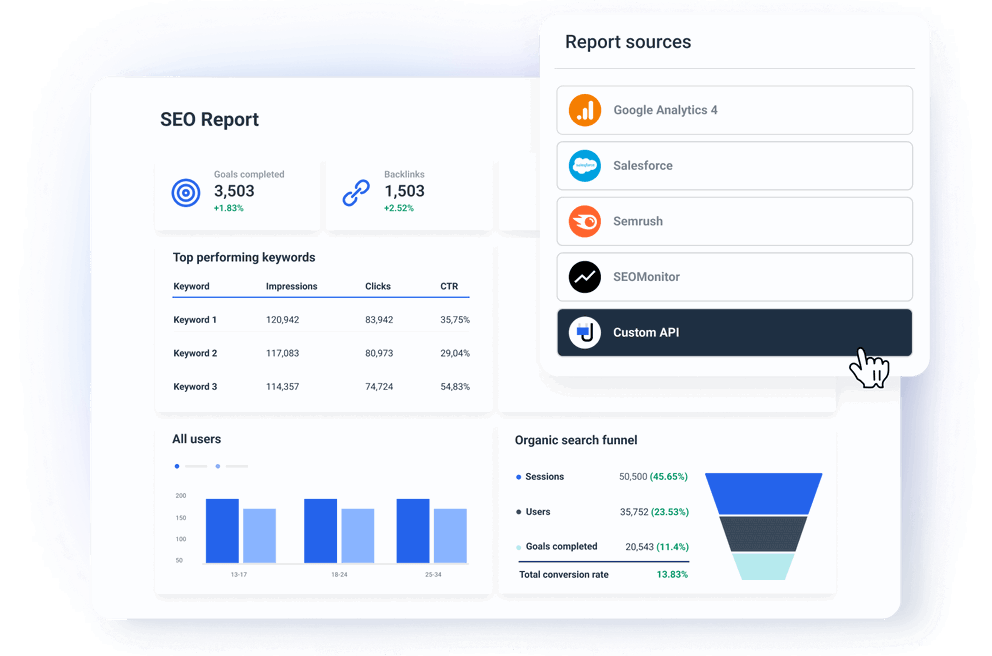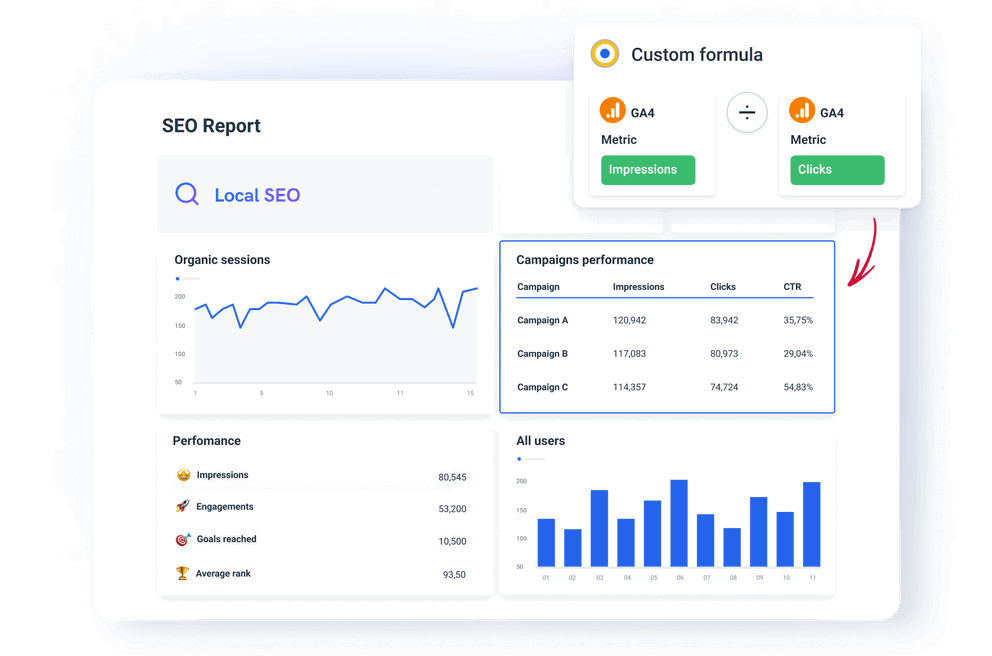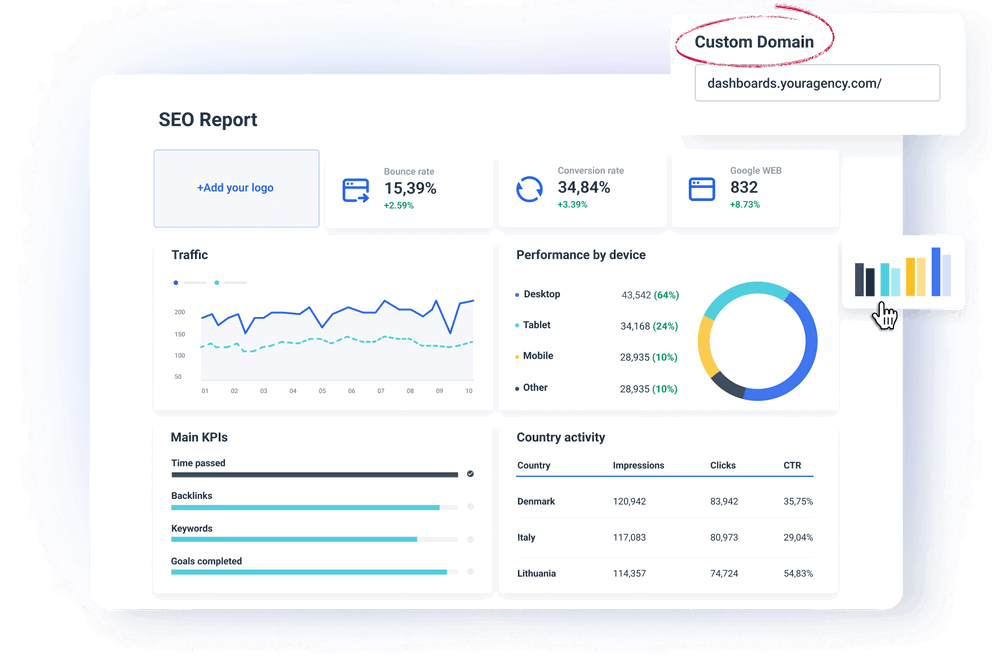What exactly is white label SEO reporting?
White label SEO reports allow digital marketing agencies to deliver high-quality, branded reports without the need for extensive in-house development.
Dedicated white label SEO analysis tools let you create these reports and add your own brand’s colors, logos, icons, headers, and other design elements.
How do I choose the best white label SEO reporting tool for my agency?
Not all white label SEO reporting software are created equal. Some offer better customization, pre-made templates, and more reliable integrations.
This is what we recommend prioritizing:
1. White-labeling features
This is the essence of a good white label SEO platform. It should give you full control over creating branded SEO reports.
You should be able to:
- Change the color schemes in your reports
- Embed your logos and custom messaging
- Add comment boxes, notes, and headers
- Pick different colors for graphs and charts
- Customize the automated emails going to clients
- Personalize the cover landing page
- Use your own domain
- Use emojis
In addition, it should be possible to fully remove the SEO reporting tool's own branding.
(Psst. on Whatagraph, you can apply all of the above changes, and much more!)
2. Integrations with all SEO platforms
White-labeled reports aren’t enough if the integrations don’t deliver.
To create SEO reports effectively, the tool should integrate with all the major SEO tools, including:
- Ahrefs
- SE Ranking
- Semrush
- SEOMonitor
- AccuRanker
- Google My Business
- Google Search Console
- Google Analytics 4
On Whatagraph, you can connect with all of these platforms in a few clicks.
We also integrate with 50+ other PPC, ecommerce, email marketing, analytics, and social media platforms.
3. Stable and reliable integrations
Not only should SEO integrations be available, but they should also be stable and reliable.
Most reporting tools will use third-party connectors, but they can cause issues for agencies, such as:
❌ Unreliable data due to broken APIs or outdated connectors
❌ Authentication problems that require constant re-login
❌ Network and latency issues that slow down creating reports
❌ Data compatibility issues that make it hard to merge data
On Whatagraph, all of our integrations are fully managed—meaning they’re more reliable, seamless, and regularly maintained.
These integrations pull data from multiple sources automatically and normalize it into usable formats ready for accurate reporting. No manual cleaning or prepping needed.
4. Live chat support
No matter how intuitive your white label SEO reporting tool is, you may need help at times.
At times like this, it’s important that you can contact customer support if necessary.
This is where Whatagraph sets itself apart from most of the best SEO reporting tools—all of our users get access to world-class support. Our users get:
- Live chat and email support, with under 4-minute first response times
- A dedicated Customer Success Manager, who helps with everything from initial setup to advanced customization
Your CSM personally helps you with onboarding and is your direct line of support for bigger issues.
Most issues get resolved within 4-24 hours, and for anything more complex, we send daily progress updates, so you know what’s going on.
How can I create a white label SEO report for my clients?
The fastest way to create a white-label SEO report for your clients is to use a dedicated all-in-one reporting tool, like Whatagraph.
On Whatagraph, you can create a white-label SEO report in five steps:
1. Add your SEO data sources
The first thing to do is to connect your SEO data sources, which you can do in a few clicks on Whatagraph.
From our dashboard, select your data source (e.g., Ahrefs or Semrush), and authenticate yourself via login. The data will start flowing in immediately.
2. Organize your data
Organizing your data helps keep your SEO dashboard clean and easy to digest for your team and clients.
This process involves:
- Creating data blends from different sources
- Standardizing campaign names
- Unifying dimension names
- Matching metric names
- Segmenting data by country or region
All of this means that your clients can quickly find what matters most to them.
3. Create your SEO report
After organizing your data, you can get straight into creating your SEO report.
You’ve got three ways to do this with Whatagraph:
- Use our pre-made white label SEO dashboards or SEO reports
- Start from a blank page
- Use our smart builder
For each SEO report, you can add drag-and-drop widgets, create your own custom metrics, apply team templates, and more.
Our widget library goes well beyond basic charts. You can choose from detailed pivot tables, comparison widgets, interactive donut charts, single-metric KPI cards, and dozens more data visualization options.
4. Add white-labeling to your client reports
Once you’ve added SEO KPIs to your reports, it’s time to white-label them.
On Whatagraph, you have full control over how your reports look. You can:
- Change the header: You can modify the report header. This is one of the first things clients see.
- Add your own logo: You can replace the “Powered by Whatagraph” text with your own custom logo in both the header and the footer.
- Change the color themes: Whatagraph has pre-made color themes, but alternatively, you can add your own.
- Change icons: Displayed next to the widgets and charts—you can add icons from our icon library.
- Create white-labeled emails: To modify the look of your automated emails, you can customize your email style.
- Add a custom domain: Change the Whatagraph domain to any other domain.
You can also create custom email themes like:
- The subject line
- Body text and descriptions
- The button text
- The footer text
- Logos inside the email
To save time, you can save these custom themes as templates and use them across multiple reports for multiple clients.
5. Share the report
Once your report is ready, you’ve got a few ways to share it:
- White-label delivery: Use your own sender details and custom domain
- Automated emails: Schedule automated emails (daily, weekly, or monthly)
- Live links: Create a live link and share it with anyone you’d like
- CSV or PDF reports: Export reports as a file—perfect for offline access































